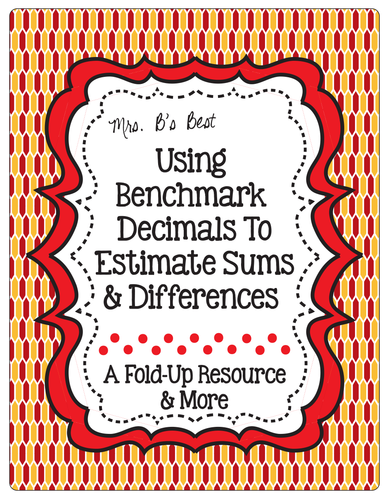
Use Benchmark Decimals to Estimate Sums and Differences!
Decimal benchmarks are decimals that are easily recognizable and include the 0, 0.25, 0.50, 0.75 and 1.
Students are asked to round decimals to the nearest benchmark decimal (0, 0.25, 0.50, 0.75 and 1) and then add or subtract the 'rounded' decimal. To aid students in this process, I created a benchmark decimal number line. This number line allows students to 'see' which benchmark they should round to.
This product includes:
• Tri-fold fold up which would work well in a math journal. The tri-fold up has a front cover and an inside. It contains a number line, definitions and two examples. *Be sure to run a test copy to make sure it folds up properly. The outside cover is intentionally upside down for easier copying.
• Large front and back explanation sheet. This sheet is really just a large version of the fold-up. The examples given, however, are different. This sheet also provides slightly more detail on the process.
• Sheet containing the parts to make a 'jumbo' decimal benchmark number line...this could be stored in the 'tools' pocket of a math journal. Also included on this page is a 'mini' decimal benchmark number line...this could be taped on a child's desktop or glued into a math journal.
• Two-sided practice sheet which contains both decimal addition and subtraction problems. The directions ask students to round to the nearest benchmark decimal and then solve.
• Answer key for two-sided worksheet.
Decimal benchmarks are decimals that are easily recognizable and include the 0, 0.25, 0.50, 0.75 and 1.
Students are asked to round decimals to the nearest benchmark decimal (0, 0.25, 0.50, 0.75 and 1) and then add or subtract the 'rounded' decimal. To aid students in this process, I created a benchmark decimal number line. This number line allows students to 'see' which benchmark they should round to.
This product includes:
• Tri-fold fold up which would work well in a math journal. The tri-fold up has a front cover and an inside. It contains a number line, definitions and two examples. *Be sure to run a test copy to make sure it folds up properly. The outside cover is intentionally upside down for easier copying.
• Large front and back explanation sheet. This sheet is really just a large version of the fold-up. The examples given, however, are different. This sheet also provides slightly more detail on the process.
• Sheet containing the parts to make a 'jumbo' decimal benchmark number line...this could be stored in the 'tools' pocket of a math journal. Also included on this page is a 'mini' decimal benchmark number line...this could be taped on a child's desktop or glued into a math journal.
• Two-sided practice sheet which contains both decimal addition and subtraction problems. The directions ask students to round to the nearest benchmark decimal and then solve.
• Answer key for two-sided worksheet.
Something went wrong, please try again later.
This resource hasn't been reviewed yet
To ensure quality for our reviews, only customers who have purchased this resource can review it
Report this resourceto let us know if it violates our terms and conditions.
Our customer service team will review your report and will be in touch.
$3.00
